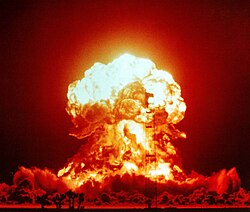
Back انفجار نووي Arabic Nuklearna eksplozija BS Jaderný výbuch Czech Нуклонсарла сирпĕнӳ CV Kernwaffenexplosion German Πυρηνική έκρηξη Greek Atomkerna eksplodo Esperanto Explosión nuclear Spanish انفجار هستهای Persian Explosion atomique French

| Nuclear weapons |
|---|
 |
| Background |
| Nuclear-armed states |
|
A nuclear explosion is an explosion that occurs as a result of the rapid release of energy from a high-speed nuclear reaction. The driving reaction may be nuclear fission or nuclear fusion or a multi-stage cascading combination of the two, though to date all fusion-based weapons have used a fission device to initiate fusion, and a pure fusion weapon remains a hypothetical device. Nuclear explosions are used in nuclear weapons and nuclear testing.
Nuclear explosions are extremely destructive compared to conventional (chemical) explosives, because of the vastly greater energy density of nuclear fuel compared to chemical explosives. They are often associated with mushroom clouds, since any large atmospheric explosion can create such a cloud. Nuclear explosions produce high levels of ionizing radiation and radioactive debris that is harmful to humans and can cause moderate to severe skin burns, eye damage, radiation sickness, radiation-induced cancer and possible death depending on how far a person is from the blast radius.[1] Nuclear explosions can also have detrimental effects on the climate, lasting from months to years. A small-scale nuclear war could release enough particles into the atmosphere to cause the planet to cool and cause crops, animals, and agriculture to disappear across the globe—an effect named nuclear winter.[2]
- ^ "CDC Radiation Emergencies | Frequently Asked Questions About a Nuclear Blast". www.cdc.gov. 2019-04-22. Retrieved 2021-04-29.
- ^ Rubinson, Paul (2014-01-02). "The global effects of nuclear winter: science and antinuclear protest in the United States and the Soviet Union during the 1980s". Cold War History. 14 (1): 47–69. doi:10.1080/14682745.2012.759560. ISSN 1468-2745. S2CID 153883165.